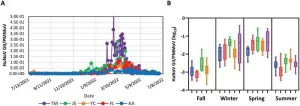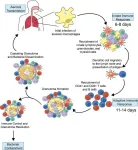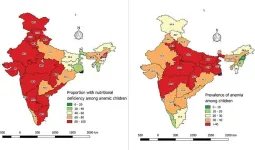(Press-News.org) Temperature, day length and humidity have been found to be linked to the increased spread of a diarrhoeal illness a new study from the University of Surrey reveals. The findings could help predict further outbreaks of the illness, potentially leading to better preparedness within health services.
During this unique study, researchers led by Dr Giovanni Lo Iacono, investigated the impact of weather on the transmission of campylobacteriosis, a bacterial infection which can cause diarrhoea and stomach pains. According to the World Health Organisation, Campylobacter infections are the most common causes of human bacterial gastroenteritis in the world. Infections are generally mild, but can be fatal among very young children, elderly, and immunosuppressed individuals.
Dr Giovanni Lo Iacono, Senior Lecturer in Biostatistics and Epidemiology, in the School of Veterinary Medicine at the University of Surrey and who contributed to the recent UKSHA Health Effects of Climate Change, said:
“Since Hippocrates, there has been a large consensus that weather and climate influence the spread of diseases. Getting to the bottom of why this is and what specific environmental factors drive the spread of disease is a complicated matter and not fully understood. We now have a detailed description of how the weather affects the disease, and the next step is to understand the why. Importantly, through our transparent and conceptually simple approach, we can now tell the risk of getting the disease when we know the recent local weather.
“This information is invaluable, as illnesses such as campylobacteriosis not only cause discomfort to individuals, but have enormous societal impacts, with people having to call in sick to work and puts extra pressure on health services across the world.”
To determine if weather impacts incidences of campylobacteriosis, researchers analysed data from approximately one million cases of campylobacteriosis in England and Wales over a 20-year period from UKHSA. An innovative mathematical model was developed by the team enabling them to compare this data provided by the Met Office with weather parameters at the time.
Analysis of this data showed incidences of campylobacteriosis were consistent below temperatures of eight degrees Celsius. However, a sharp increase in infection (approximately one case per million) were observed for every five degree rise in temperature, where temperatures were between eight to 15 degrees Celsius. A link to humidity was identified by the team who also observed high incidents of infection when levels of water vapour in the air were between 75- 80 percent.
Interestingly, researchers observed strong associations between day length (longer than 10 hours) and increased cases of the illness. This association was further strengthened when humidity was also high. Rainfall and wind- speed were not strongly linked to the spread of campylobacteriosis.
Dr Lo Iacono, added:
“What we have found is that rising temperatures, humidity and increased day length are associated with the spread of campylobacteriosis. We do not fully understand why this may be. It could be that warm weather increases the survival and spread of pathogenic bacteria (so the weather causes the disease) or alternatively it could be people’s behaviour and how they socialise during such periods.
“However, what we do know is climate change not only has an environmental impact but has the potential to negatively affect our health by aiding the spread of infectious diseases.”
Gordon Nichols, a visiting Professor at the University of Surrey, said:
“Environmental data can help us understand complex patterns in the spreads of diseases. Having this knowledge is invaluable as it can help us identify areas vulnerable to potential outbreaks and ensure they have the resources available to treat people affected and to curb the spread of disease into other areas.”
This study was published in the journal PLOS Computational Biology (Link will be live when paper is published)
Notes to editors
Dr Giovanni Lo Iacono is available for interview on request
For more information please contact mediarelations@surrey.ac.uk END
Climate change linked to spread of diarrheal illness
2024-01-18
ELSE PRESS RELEASES FROM THIS DATE:
Injectable agents could improve liquid biopsy for cancer detection and monitoring
2024-01-18
Scientists have developed two agents, made of therapeutic nanoparticles and antibodies, that could be given to patients shortly before a blood draw to allow physicians to better detect tumor DNA in blood using a technology called liquid biopsy.
Liquid biopsies promise to transform how cancers are diagnosed, monitored, and treated by detecting DNA that tumors shed into the blood. But the body presents a significant challenge. Immune cells in the liver and DNA-degrading enzymes in blood remove circulating tumor DNA from the bloodstream within minutes, making this DNA difficult to capture and detect in a blood test.
To overcome this, a team from the Broad Institute of MIT and Harvard ...
A fungal pathogen, Rosellinia necatrix, that attacks plants, produces antimicrobials to combat the plant-hosted bacteria that would otherwise inhibit its infection success
2024-01-18
A fungal pathogen, Rosellinia necatrix, that attacks plants, produces antimicrobials to combat the plant-hosted bacteria that would otherwise inhibit its infection success.
####
Article Title: The soil-borne white root rot pathogen Rosellinia necatrix expresses antimicrobial proteins during host colonization
Article URL: http://journals.plos.org/plospathogens/article?id=10.1371/journal.ppat.1011866
Author Countries: Germany, Spain, the Netherlands
Funding: EACC and DET acknowledge receipt of PhD fellowships from CONACyT, Mexico. ALM is holder of a postdoctoral research fellow funded by the 'Fundación Ramón Areces'. BPHJT ...
Researchers improve blood tests’ ability to detect and monitor cancer
2024-01-18
CAMBRIDGE, MA -- Tumors constantly shed DNA from dying cells, which briefly circulates in the patient’s bloodstream before it is quickly broken down. Many companies have created blood tests that can pick out this tumor DNA, potentially helping doctors diagnose or monitor cancer or choose a treatment.
The amount of tumor DNA circulating at any given time, however, is extremely small, so it has been challenging to develop tests sensitive enough to pick up that tiny signal. A team of researchers from MIT and the Broad Institute of MIT and Harvard has now come up with a way to significantly boost that signal, by temporarily slowing the clearance of tumor DNA circulating in the bloodstream.
The ...
Sea otters may be key drivers of changes in California's kelp forests, according to data spanning a century
2024-01-18
Sea otters may be key drivers of changes in California's kelp forests, according to data spanning a century
#####
In your coverage please use this URL to provide access to the freely available article in PLOS Climate: https://journals.plos.org/climate/article?id=10.1371/journal.pclm.0000290
Article Title: Sea otter recovery buffers century-scale declines in California kelp forests
Citation: Nicholson TE, McClenachan L, Tanaka KR, Van Houtan KS (2024) Sea otter recovery buffers century-scale declines in California ...
Norovirus outbreaks are detectable by wastewater monitoring earlier than by other surveillance methods depending on reporting practices, making this a potentially important public health tool
2024-01-18
Norovirus outbreaks are detectable by wastewater monitoring earlier than by other surveillance methods depending on reporting practices, making this a potentially important public health tool.
####
Article URL: https://journals.plos.org/water/article?id=10.1371/journal.pwat.0000198
Article Title: Norovirus GII wastewater monitoring for epidemiological surveillance
Author Countries: USA
Funding: This study was supported by funding from the University of Michigan through the Public Health Infection ...
Climate change may reduce life expectancy by half a year, study suggests
2024-01-18
The cost of climate change may be six months off the average human lifespan, according to a study published January 18, 2024, in the open-access journal PLOS Climate by Amit Roy from Shahjalal University of Science and Technology and The New School for Social Research, U.S.
Temperature and rainfall — two telltale signals of climate change — cause myriad public health concerns, from the acute and direct (e.g., natural disasters like flooding and heat waves) to the indirect yet equally devastating (e.g., respiratory and mental illnesses). While impacts like these are observable and well documented, existing research has not established a direct link between climate change and life ...
Remodeling the immune system to fight tuberculosis
2024-01-18
AMHERST, Mass. – Tuberculosis, caused by the bacterium Mycobacterium tuberculosis (Mtb) kills upwards of 1.6 million people a year, making it one of the leading causes of death by an infectious agent worldwide—and that number is only growing larger. How, exactly, Mtb evades the immune system isn’t yet known, but a collaborative team of researchers from the University of Massachusetts Amherst and Seattle Children’s Research Institute recently discovered something surprising: prior exposure to a genus of bacteria called Mycobacterium seems to remodel the first-line defenders in the body’s immune system. Furthermore, how ...
6 in 10 sampled under-5s in India have micronutrient deficiencies, and 4 in 10 have anaemia, per survey of 17,230 children
2024-01-18
6 in 10 sampled under-5s in India have micronutrient deficiencies, and 4 in 10 have anaemia, per survey of 17,230 children.
####
Article URL: https://journals.plos.org/globalpublichealth/article?id=10.1371/journal.pgph.0002095
Article Title: Prevalence and determinants of anemia due to micronutrient deficiencies among children aged 12–59 months in India–Evidence from Comprehensive National Nutrition Survey, 2016–18
Author Countries: India
Funding: The authors received no specific funding for this work. END ...
DNA becomes our ‘hands’ to construct advanced nanoparticle materials
2024-01-18
Evanston, IL In a paper to be published in Science Jan. 18, scientists Chad Mirkin and Sharon Glotzer and their teams at Northwestern University and University of Michigan, respectively, present findings in nanotechnology that could impact the way advanced materials are made.
The paper describes a significant leap forward in assembling polyhedral nanoparticles. The researchers introduce and demonstrate the power of a novel synthetic strategy that expands possibilities in metamaterial design. These are the unusual materials that underpin “invisibility cloaks” and ultrahigh-speed optical computing systems.
"We manipulate ...
Repeated sexual failures cause social stress in fruit flies
2024-01-18
Repeated failures to reproduce make fruit flies stressed and frustrated, which in turn makes them less resilient to other types of stress, Julia Ryvkin at Bar-Ilan University and colleagues report in the open-access journal PLOS Genetics, publishing January 18.
Animals are motivated to take actions that improve their survival and reproduction through reward systems in the brain, but failure causes stress. The reward systems have been extensively studied, but less attention has been paid to how animals respond to failure. To investigate, researchers compared ...




